|
 |
| |
| During
your holy land pilgrimage, you will be seeing these
symbols in churches and synagogues, on doorways and
signposts, in souvenir shops and outdoor bazaars.
Here's the story behind each icon: |
| |
|
MENORAH |
| |
|
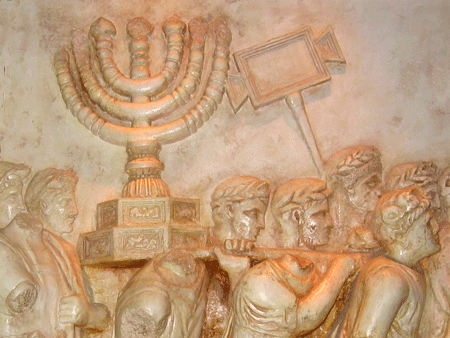 |
|
Photo: Gila
Yudkin |
|
The 7-branched menorah being taken
as booty from the Jerusalem Temple |
| |
| The
menorah was the seven-branched candelabrum first
designed for the Tabernacle according to the Lord’s
instructions. |
| |
“Make a lampstand of pure gold and hammer it
out, base and shaft; its flowerlike cups, buds and
blossoms shall be of one piece with it.”
Exodus 25:31
|
Three
branches extended out from each side with cups
shaped like almond blossoms and buds. The
candelabrum was lit every evening with the purest of
olive oil. Some believe that the Menorah symbolized
the burning bush seen by Moses on Mount Sinai.
The 7-branched menorah stood in both Solomon’s
Temple and in the Second Temple of Jesus’ day.
Josephus the Jewish/Roman historian wrote that the
seven branches represented the universe with its
seven planets (known in the Roman world).
When the Romans conquered Jerusalem in 70 AD, they
captured the menorah and brought it back to Rome.
It was prominently paraded around the capital city
and was featured on Roman emperor Titus’ victory
column in the Roman Forum.
Once the Temple was destroyed, the menorah became a
symbol of Jewish aspirations to rebuild the Temple.
When you are in Jerusalem’s Jewish Quarter, don’t
miss viewing a replica of the 7-branched golden
menorah constructed by the Temple Institute. |
| |
|
LOAVES
AND FISH |
| |
|
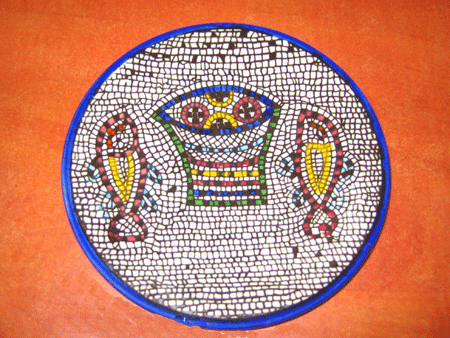 |
|
Photo: Gila
Yudkin |
|
Souvenir plate showing the loaves
and fish mosaic from Tabgha |
| |
| The
feeding of the five thousand by the shores of the
Sea of Galilee is the only miracle recorded in all
four Gospels. (Matthew 14:21, Mark 6:44, Luke 9:14,
John 6:10) |
| |
“We have here only five loaves of bread and
two fish,” they answered. “Bring them here
to me,” he said.
Matthew 14:17-18
|
When
the hour was getting late, the disciples asked Jesus
whether they should go into town to get food for the
multitudes who were enthralled by Jesus’ teaching.
With only five loaves and two fish, Jesus looked up
to heaven, blessed and broke the loaves and gave
them to the disciples who distributed them to the
crowd of five thousand men plus women and children.
On the western shore of the Sea of Galilee, a fourth
century floor mosaic of the fish and loaves has been
preserved and can be viewed at
Tabgha,
the site of a modern Benedictine chapel
commemorating the feeding of the five thousand.
Today, replicas of the loaves and fish mosaic are
extremely popular souvenir items. The “loaves and
fish mosaic” is reproduced on ceramic serving
dishes, Armenian glazed coffee mugs, chalices and
wall tiles, to name a few. |
| |
|
JERUSALEM
CROSS |
| |
|
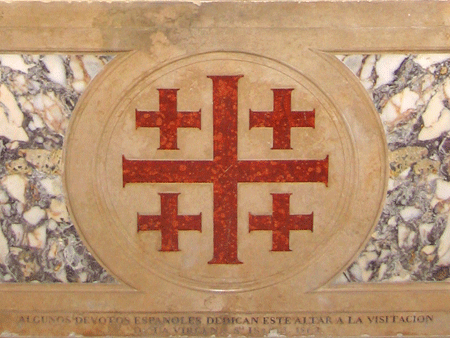 |
|
Photo: Gila
Yudkin |
|
Jerusalem Cross found on the
Via
Dolorosa |
| |
| The
Jerusalem Cross, with four small crosses surrounding
a large cross (with all the bars equidistant from
the center), was first used as a coat of arms for
the Latin Kingdom in Jerusalem, established when the
Crusaders conquered the Holy City and the Holy
Sepulcher in 1099. |
| |
Then Jesus told his disciples, “If any want
to become my followers, let them deny themselves
and take up their cross and follow me.”
Matthew 16:24
|
Some
say that the large cross represents Jerusalem and
the four smaller crosses represent the four corners
of the earth to which the four Gospels spread.
Another explanation is that the five crosses
represent the five Crusader armies (Great Britain,
France, Germany, Italy and Spain) who came to
liberate Jerusalem. Yet another explanation
has it that the five crosses represent the stigmata,
the five wounds of Jesus.
You will see the Jerusalem Cross decorating gates
and chapels belonging to the Franciscan Order of the
Roman Catholic Church. The Basilica of the
Annunciation in Nazareth has an exquisite rendition
of the Jerusalem Cross in stained glass. It is
also a very popular shape for a gold pendant,
sometimes decorated with ancient Roman glass. |
| |
Coming to Jerusalem
this year? Are you coming from very
far away and want every minute to matter?
Would you like to experience both the authentic
and the traditional sites, yet you are most
interested in finding the venues where you can
quietly be transported back in your imagination to
the time of Jesus? David? Abraham?
Make every minute matter while you "Explore
Jerusalem's Soul" with
Gila's Jerusalem Guide.
The up-to-date PDF (Adobe Acrobat) 46-page guide
gives you the Top Ten places to meditate on the
Bible, the Top Ten lesser-known churches worth
visiting, the Top Ten most rewarding roof-top
views and the top Ten places for Middle Eastern
food. More...
|
|
SHOFAR |
| |
|
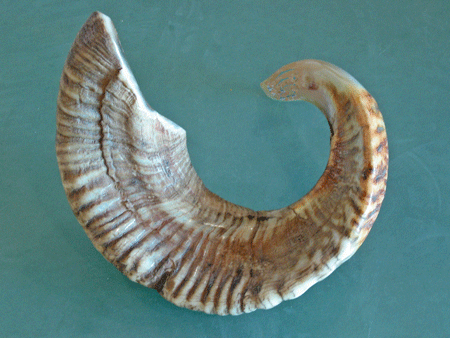 |
|
Photo: Gila
Yudkin |
|
Shofar or ram's horn |
| |
| A shofar
comes from the horn of a ram (a male sheep) or goat
or antelope (kudu). Yemenite Jews did not have sheep
or goats, so they used the horn of an antelope. Most
animal horns can be used, except for the cow, which
is reminiscent of the golden calf. |
| |
“When they make a long blast with the ram’s
horn, as soon as you hear the sound of the
trumpet, then all the people shall shout with a
great shout; and the wall of the city [Jericho]
will fall down flat, and all the people shall
charge straight ahead.”
Joshua 6:5
|
Scripture tells us that a ram was caught in the
thicket at Mount Moriah and sacrificed instead of
Isaac. (Genesis 22:13) The first blowing of
the shofar was when God called the people to worship
at Mount Sinai. The first shofars would
have been ram’s horns, which were available only
after the death of the animal.
The shofar is blown in synagogues today during the
high holy days of Rosh HaShana celebrating the
Jewish New Year. Ten days later, the Yom
Kippur (Day of Atonement) worship service ends with
a mighty blast of the shofar.A shofar and a
menorah carved into the capital of a column found
near an impressive white limestone structure at
Capernaum helped identify that building
as a synagogue. |
| |
Tour the Temple
Mount in the
company of Abraham and Isaac, David and Solomon,
Jesus and the disciples, the angel Gabriel and
Mohammed -- and Gila. Meet many other luminaries,
both real and legendary.
Gila's Temple Mount tour
is now available as a written
24-page PDF with a
Temple Mount plan,
guidelines for passing the security check
and ten recommended reads on the
Temple Mount from Gila's bookshelves.
|
|
POMEGRANATE |
| |
|
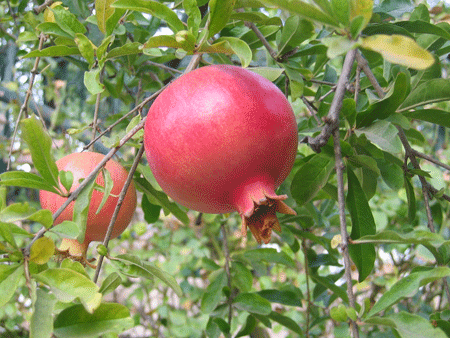 |
|
Photo: Gila
Yudkin |
|
Pomegranates are one of the seven
species once brought as gifts to the Temple |
| |
| The
pomegranate is named as one of the “seven species”
of fruits and grains found throughout the Promised
Land, the land of milk and honey. |
| |
“For the Lord your God is bringing you into
a good land, a land with flowing streams, with
springs and underground waters bursting out of
valleys and hills, a land of wheat and barley, of
vines and fig trees and pomegranates, a land of
olive trees and honey.”
Deuteronomy 8:7-8
|
The
pomegranate is a symbol of fertility because it’s
filled with seeds. It reminds us of the first
commandment which is to be fruitful and multiply.
(Genesis 1:28) The rabbis said that the 613
seeds in the pomegranate represent the 613
commandments in the Torah (five books of Moses).
In Exodus 28:33-34 there is a description of the
robe of the high priest with the added instruction,
“On its hem make pomegranates of blue, purple and
crimson yarns, all around the hem, with bells of
gold between them all around: a golden bell and a
pomegranate, a golden bell and a pomegranate, all
around the robe.
The Archeology Wing of the Israel Museum exhibits an
ivory pomegranate with an 8th century BC
inscription. Some scholars believe that this
pomegranate graced the head of a scepter and may
have been carried by a priest into Solomon’s Temple.
In the Second Temple, during the time of Jesus, it’s
said that when the high priest entered the Holy of
Holies on the Day of Atonement, (Yom Kippur), there
was a rope around his ankle, so that if he would
happen to faint, or have a heart attack, the
pomegranates and bells would ring an “alarm” and the
high priest could be pulled out by the rope, without
anyone desecrating the divine space. |
| |
|
ST
PETER'S FISH |
| |
|
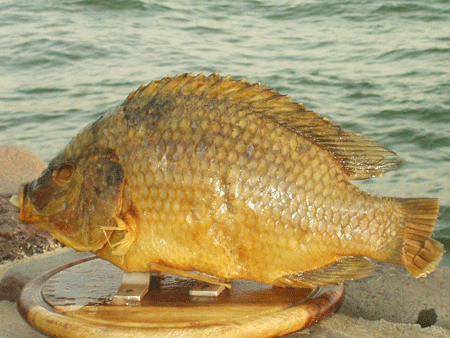 |
|
Photo: Gila
Yudkin |
|
St. Peter's fish caught in the Sea
of Galilee |
| |
| St.
Peter’s fish is said to be found naturally in only
two places: the Sea of Galilee and Lake Victoria at
the headwaters of the Nile. It’s called St.
Peter’s fish because of the following passage: |
| |
“When they came to Capernaum, the collectors
of the half-shekel tax went up to Peter and said,
‘Does you teacher pay the tax?’ ….Go to the sea
and cast a hook, and take the first fish that
bites. Open its mouth and there you will find a
shekel. Take that and give it to them for me and
for yourself.”
Matthew 17: 24-27
|
| This
type of fish which you may know as Tilapia is called
a mother mouth-breeder. Because it breeds its babies
in its mouth, the fish is often caught by fishermen
with a little pebble, a bottletop, or even a small
coin like a shekel in its mouth. Jesus and the
disciples probably ate St. Peter’s fish when they
were living at Peter’s mother-in-law’s house at
Capernuam. It may have two St. Peter’s fish
along with five loaves that fed the 5,000 men plus
women and children on the shores of the Sea of
Galilee. |
| |
| You will
have an opportunity to taste St. Peter’s fish on
your tour. Don’t miss it – you may even find a
shekel in its mouth! |
| |
|
DATE
PALMS |
| |
|
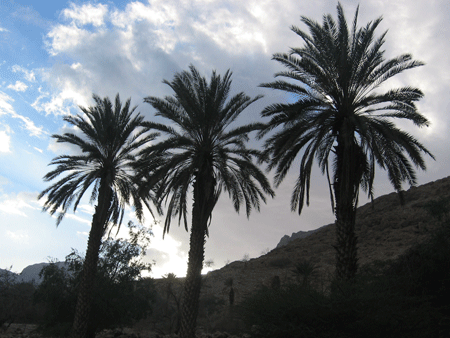 |
|
Photo: Gila
Yudkin |
|
En Gedi was called the city of
date palms in the time of Jesus |
| |
| The Land
of Canaan which was promised to the children of
Israel was called the "Land of Milk and Honey." |
| |
"I declare that I will bring you up out of
the misery of Egypt, to the land of the
Canaanites, the Hittites, the Amorites, the
Perizzites, the Hivites, and the Jebusites, a land
flowing with milk and honey."
Exodus 3: 17
|
| Many
scholars think that the milk was goat milk and the
honey, date honey, one of the most popular sweets in
the ancient times. Judea abounded with both
goats and date palms. When the
Romans wanted to boast that Judea had been captured,
they issued a coin showing a woman sitting with a
bowed head, under a date palm. On your
holy land pilgrimage, you will have lots of
opportunities to taste the varieties of holy land
dates. |
|
|
|
"JESUS
BOAT" |
|
|
|
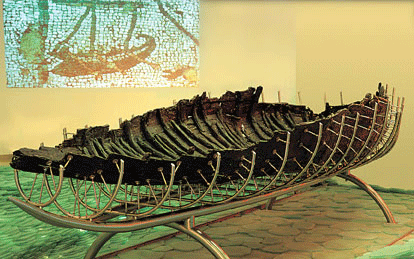 |
|
Photo:
courtesy of the Jesus Boat Shop |
|
Remains of boat which sailed the
Sea of Galilee 2,000 years ago |
|
|
|
In 1986 two fishermen found the remains of a two
thousand year old boat by Magdala, Mary Magdalene’s
hometown, on the shores of the Sea of Galilee. |
|
|
“He said, ‘Come.’ So Peter got out of the
boat, started walking on the water, and came
toward Jesus.”
Matthew 14:29
|
|
Made of 12 kinds of wood, the boat is almost 30 feet
long, over 7 feet wide and 4 feet deep. Its
measurements suit that type of boat used by
fishermen with a dragnet. (Matthew 13:47-48)
Apparently the craft had been in use for many years,
as could be seen from numerous spots in which
repairs had been made. A number of beams and
strakes seemed to have been use previously on other
boats, which explains the variety of wood types. |
|
|
|
Because of an oil lamp and a couple of coins found
in the boat, it is dated to the first century A.D.
It’s the only fishing vessel ever found along the
shores of the Sea of Galilee from the days of Jesus.
Today every Bible encyclopedia illustrates fishing
on the Sea of Galilee with a photo or drawing from
this very boat, dubbed the “Jesus boat.” |
|
|
|
COMING TO
JERUSALEM?
BOOK GILA for your customized private tour |
|
MEZUZAH
Mezuzah
literally means “doorpost.” It is a
decorated rectangular silver, brass,
ceramic, olive wood, or stone box that Jews
attach to the doorpost of their house and
gates.
"And you shall write them upon the
doorposts of your house, and upon your
gates."
Deuteronomy 6: 9
The box contains parchment inscribed with
biblical verses from the Shm’a (“Hear
O Israel, the Lord Our God, the Lord is
One”) prayer in Deuteronomy 6. On the outside of the box is inscribed
the first letter, shin, or all the Hebrew
letters of Shaddai, the name which the Lord
revealed to Abraham when he offered His
covenant.
|
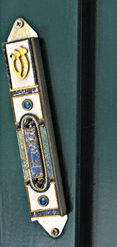
Photo:
Gila Yudkin
Mezuzah |
|
|
|
|
Look for a mezuzah on the door to
your hotel room. You will find a wide
selection of mezuzahs in nearly every Jewish
gift shop. |
|
|
|
HAMSEH |
|
|
|
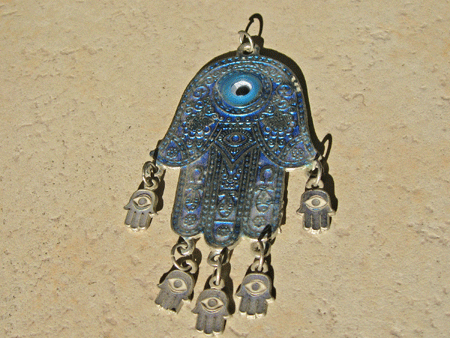 |
|
Photo: Gila
Yudkin |
|
Hamseh hanging in
Gila's Jerusalem home |
|
|
|
The hamseh (literally "five" in
Arabic) is a hand with the palm facing
outward in order to ward off the "evil eye"
(i.e. bad luck). It's a symbol of
blessing and protection, often worn as an
amulat, to protect the wearer from evil. |
|
|
|
The hamseh is also known as the hand
of Fatima. Fatima was the daughter of
Mohammed, founder of Islam. Jews and
Christians from Muslim countries adopted
this folk symbol which brings good fortune.
If you visit the Joseph Caro Synagogue in
Safed in the Upper Galilee, you will see
hanging light fixtures decorated with a
hamseh. You will find the hamseh
portrayed on wall hangings and tapestries,
on decorative ceramic wall plaques and on
gold and silver pendants. |
|
|
|
Copyright 2006,
2011
Gila Yudkin. Permission needed for any reuse. |
|
|
|
Don't miss these biblical
sites: |
|
|
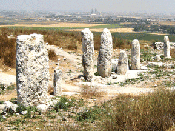 |
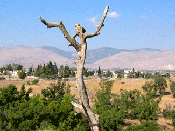 |
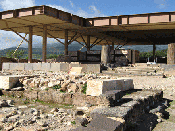 |
|
Solomon & Gezer
|
King Saul & Beth Shean |
Joshua at Hazor |
| |
|
|
|
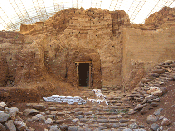 |
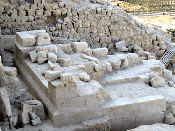 |
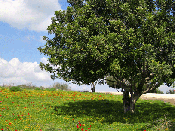 |
|
Abraham at Dan
|
Herod's tomb found! |
David versus Goliath |
|
|
|
|
How
to lead a tour that's a rave success! |
|
|
|
Mark
Twain's Holy Land Tips |
|
|
|
Mount of
Olives: FUN things to DO |
|
|
|
10 Tips
for a Terrific Temple Mount Tour |
|
|
|
|

